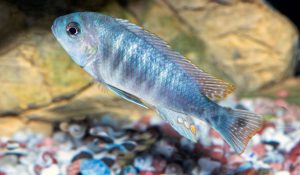Keeping and caring for fish can be a rewarding and enjoyable hobby. One captivating species that attracts many aquarium enthusiasts is the blue parrot fish. In this comprehensive guide, we will delve into various aspects of blue parrot fish, including their size, female characteristics, suitable tank mates, mini variants, tank size requirements, compatibility with other species, and keeping them as pets. So, let’s dive into the vibrant world of blue parrot fish and explore what makes them truly special.
Table of Contents
Blue Parrot Fish Size
General Size Range
Blue parrotfish possess an array of sizes; most mature specimens will attain an average length ranging from about 12 – 20 inches (30 – 50cm). However, it’s essential to acknowledge that individual fish may vary significantly across several factors like genetics and environmental influences such as diet and habitat conditions.
Factors Affecting Size
The size of blue parrot fish is influenced by several factors. Genetics plays a significant role, as certain breeding lines may produce larger or smaller individuals. Additionally, their environment and diet have a direct impact on growth. Providing optimal conditions and a balanced diet rich in essential nutrients can contribute to healthy growth and the realization of their maximum potential size.
Blue Parrot Female Fish
Physical Characteristics
Female blue parrot fish can be distinguished from males by observing certain physical characteristics. Typically, females have a more rounded body shape and exhibit less intense coloration compared to their male counterparts. This distinction becomes more pronounced as they mature.
Behavior and Breeding
Female blue parrot fish play a crucial role in the breeding process. During spawning, females release eggs, while males fertilize them externally. It’s important to provide a suitable environment for breeding, including appropriate tank conditions and compatible mates. Females may display protective behaviors towards their eggs, ensuring their safety until they hatch. Proper care and attention should be given to the female during this critical phase to maximize successful breeding outcomes.
Blue Parrot Fish Tank Size
Optimal Tank Size
Blue parrotfish require spacious tanks to accommodate their active nature and potential size. A minimum tank size of 50 gallons is recommended for a single blue parrot fish. However, providing a larger tank, such as a 75-gallon or even a 100-gallon setup, allows for more freedom of movement and enhances their overall well-being.
Providing Enough Space
In addition to the tank’s physical dimensions, creating ample open swimming areas is essential. Blue parrot fish enjoy exploring their surroundings and may become stressed in cramped or cluttered environments. Providing sufficient space and ensuring a proper tank layout with suitable decorations are important considerations for their overall comfort.
Blue Parrot Fish Tank Mates

Choosing Compatible Species
Selecting compatible tank mates is crucial for creating a harmonious community aquarium with blue parrot fish. Peaceful and non-aggressive species that prefer similar water conditions can be suitable tank mates. Some examples include tetras, rasboras, and peaceful cichlids. However, always research the specific requirements and temperaments of potential tank mates to ensure a successful and stress-free cohabitation.
Creating a Harmonious Community
When introducing blue parrot fish to a community tank, it’s important to monitor their behavior and ensure that aggression or territorial conflicts do not arise. Providing ample hiding spots and visual barriers can help establish territories and reduce potential conflicts. Regular observation and appropriate adjustments to the tank setup may be necessary to maintain a harmonious balance among the different species.
Can You Keep a Blue Parrot Fish?
Feasibility as a Pet
Keeping a blue parrot fish as a pet requires careful consideration of its specific needs and the level of commitment required for its care. They are generally suitable for intermediate to experienced aquarists who are knowledgeable about maintaining stable water parameters, providing a spacious tank, and offering a varied and nutritious diet. Due to their potential size and active nature, blue parrot fish are best suited for larger aquariums with experienced owners who can provide the necessary care and attention.
Considerations for Care
To ensure the well-being of a blue parrot fish, several factors should be considered. These include maintaining optimal water quality, monitoring temperature and pH levels, providing a balanced diet consisting of high-quality pellets, flakes, and occasional live or frozen foods, and regular observation of their behavior and health. Additionally, being aware of potential diseases or infections and promptly addressing any issues is crucial for their overall health and longevity.
Polar Blue Parrot Fish Tank Mates
Compatible Tank Mates
When considering tank mates for polar blue parrot fish, it’s crucial to choose species that are compatible in terms of temperament and water requirements. Some suitable tank mates include peaceful and non-aggressive fish such as angelfish, clownfish, and gobies. Avoid pairing them with aggressive or territorial species that may stress or harm the parrot fish.
Considerations for Tank Setup
Creating an ideal tank setup for polar blue parrot fish and their tank mates involves providing sufficient space, hiding spots, and appropriate water parameters. Adequate filtration and regular water maintenance are necessary to maintain optimal water quality. Additionally, careful consideration should be given to the size of the tank, as overcrowding can lead to territorial conflicts and stress among the fish.
Mini Blue Parrot Fish

Features and Care
Mini blue parrot fish, also known as dwarf parrot fish, are smaller variants of the species. They exhibit similar vibrant colors and engaging personalities, making them popular among aquarists. Although they have a smaller size, their care requirements are comparable to their larger counterparts. Providing a suitable tank environment, a balanced diet, and regular monitoring of water parameters are crucial for their well-being.
Suitable Tank Conditions
Mini blue parrot fish thrive in tanks with ample swimming space and hiding spots. Dense vegetation, rocks, and driftwood can create a natural and stimulating environment for these fish. Maintaining stable water parameters, including temperature, pH, and hardness, is essential to ensure their health and longevity.
Conclusion
Blue parrot fish are captivating creatures with their vibrant colors and engaging personalities. Understanding their size, female characteristics, suitable tank mates, mini variants, tank size requirements, compatibility with other species, and feasibility as pets is essential for providing them with optimal care and creating a harmonious aquarium environment. By considering their specific needs and following the recommended guidelines, you can enjoy the beauty and wonder of blue parrot fish in your own aquatic world.
FAQs
1. Can blue parrot fish change their color?
Blue parrot fish have the ability to change their color slightly based on their mood, environment, and health. However, their dominant blue coloration remains relatively consistent.
2. How long do blue parrot fish live?
Blue parrot fish have an average lifespan of 8 to 10 years when provided with proper care and a suitable environment. However, with excellent care and optimal conditions, some individuals have been known to live up to 15 years.
3. Do blue parrotfish have specific dietary requirements?
Yes, while wild blue parrotfish obtain most of their essential nutrients from their natural habitat, captive blue parrotfish need additional supplementation with essential vitamins and minerals. Deficiencies in trace elements may lead to skeletal problems similar to human osteoporosis. Calcification abnormalities can occur rapidly when essential amino acid metabolites are missing.
Recommended Reading: Niger Triggerfish: A Super Healthy Fish For Your Marine Aquarium



